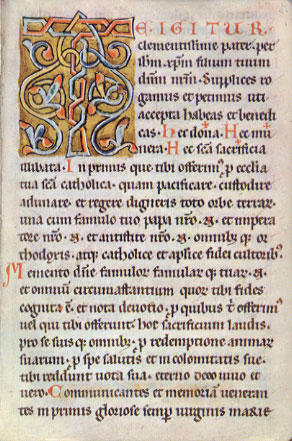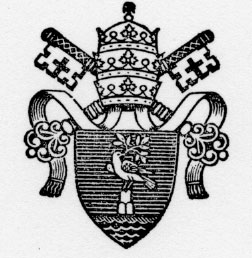 |
The Tridentine Mass takes its name from the Council of Trent (1545-63), which had called for a modest revision of the Roman rite. It was seven years after the Council Fathers had disbanded that Pope St. Pius V authoritatively issued the missal that would reflect their concerns. Informally known as the Tridentine, the missal does not so much as initiate any new practices as codify a tradition of worship which had been developing organically in Rome and other parts of Europe since the 300's. The "Tridentine rite" is therefore more properly called the old or traditional Roman rite. The last edition of its missal was published in 1962. |
||||
| The Distinctiveness of the Traditional Roman Rite East & West Though it is perhaps misleading to generalize, the traditional Roman rite differs from the other historic apostolic rites of the Church -- e.g., the Eastern -- in its focus on mystery rather than mysticism and in its adherence to a different set of apostolic traditions. Christendom's second largest liturgical tradition, the Byzantine rite, for instance, celebrates a different calendar, follows a different order of the Mass (which it calls the "Divine Liturgy"), and reflects a different approach to understanding the mysteries of redemption and sanctification. Old & New How the traditional Roman rite differs from the new Roman rite-- the 1969 Novus Ordo-- is somewhat more complicated. What are often considered the most obvious differences between the two are not, strictly speaking, differences at all. For example, many hold that the traditional Roman rite is more reverential, that it fills the soul with a sense of mystery and awe. Yet no where in the rubrics of the Novus Ordo is it stated that anything but a solemn and pious tenor should permeate the celebration of the Mass. Nor is a priest required to celebrate the new Mass facing the people or in the vernaculuar. (The traditional Roman rite deserves its other popular name, the "Latin Mass," not because it is the only rite celebrated in Latin, but because it is the only rite that can only be celebrated in Latin.) And no where in the writings of Vatican II is a church required to take down its high altar, tabernacle, or sacred images, or to eliminate distinctions between the sacred and the profane such as the communion rail. In fact, many of the characteristics we associate with the Novus Ordo are not prescribed, but violations of what is prescribed. The use of the laity as Eucharistic ministers or of girls as acolytes, for example, goes against the explicitly stated principle that such actions be taken only in case of extraordinary circumstances. These measures were intended, in other words, to be the exception, not the rule, of normative worship. Finally, to complicate matters even more, the changes that were made to the Roman liturgy tend to be exaggerated for English-speaking Catholics by the free and often inaccurate English translation of the Latin original. One fastidious Latinist has counted approximately four hundred discrepancies between the prescribed English translation made by the International Committee on English in the Liturgy (ICEL) and the Novus Ordo promulgated by Pope Paul VI. Fr. Stephen Somerville, an original member of ICEL, recently revealed in the National Catholic Register that these discrepancies were often made deliberately. "We found subtle ways of changing the words..." he stated. "We were literally changing the faith of the Catholic Church because we were changing the way it prays" (Brian McGuire, "Liturgical Translations Face Vatican Overhaul," Vol. 76, No. 4, 1/23-29/00, p. 1). For the sake of brevity (and clarity), the traditional Roman rite can be said to differ from the Novus Ordo in two areas: the Church calendar and the Mass. The Church Calendar The architects commissioned in 1967 to modify the Roman rite (two years after the close of Vatican II) brought about a number of changes to the liturgical year. "Septuagesima," the ancient season separating the jubilance of Christmastide from the penitence of Lent, was abandoned, as were Rogationtide and the apostolic observance known as Embertide. Regarding the saints' feast days, an attempt was made to restore the celebration of the saint's memory to his "birthday" into heaven (i.e. the date of his actual death), but because it was also decided that the sanctoral cycle was a hindrance to the observance of Lent, this was not always done. (St. Thomas Aquinas, for example, passed away on March 7, but because that date falls within the season of Lent, his feast was transferred to January 28.) Second, many saints, some quite famous, were dropped altogether. One hundred forty saints, including St. Christopher (formerly July 25) and St. Valentine (formerly February 14), are no longer celebrated in the current Roman calendar. And several Feasts of our Lord Jesus Christ, such as the Feast of the Most Precious Blood (formerly July 1) were also suppressed. Separately, several observances regarding fasting and feasting (some of them stretching back to apostolic times), were abandonned. The Mass The Mass can be divided into two categories: the "ordinary," or unchanging part, and the "propers," which change from week to week. The traditional Roman rite differs from the Novus Ordo in both respects. The ordinary of the traditional Roman rite includes more invocations of the Trinity, usually in a plaintive and poignant manner. It also refers more to the Blessed Virgin Mary and to the angels and saints (both individually and en masse), both as a reflection of the mediatorial character of grace and as a reminder of the celestial community to which Christians on earth are joined. The ordinary contains more references to the sacrifice of the altar and of the Cross, articulating in both its offertory prayers and in its canon a clear theology of the Eucharist. It also makes copious use of entire psalms or psalm verses at different parts of the Mass to stagger different moods and aspirations, a practice derived from the ancient Church's love of these poetic prayers. The traditional ordinary contains more Biblical allusions in an attempt to encapsulate the whole of sacred history into a single act of worship. And it tends to be more concrete and erotic in its imagery in an attempt to incorporate both space and time, mind and heart. That concreteness is reflected in the rubrics, which prescribe more physical (yet dignified) gestures for both celebrant and congregation. Finally, nothing in the traditional ordinary is changed unless it is for a reason which ties into the meaning of the liturgical season. (Because the celebrant is acting in the person of Christ, his personality and individual preferences are abstracted from entirely). This economy renders the ordinary a powerful pedagogue of word and gesture. The absence of certain lines during the liturgical year, for example, has a striking effect on the faithful. |
|||||
One of the most distinctive features of the ordinary of the traditional Roman rite is its exclusive use of its Eucharistic prayer, or canon. Though its origins are obscure, it is generally agreed that the Roman canon was last changed by Pope St. Gregory the Great in the early 600's. This made it the oldest continually used and least altered canon in Christendom. (In addition to several canons composed within the last thirty-five years, the Novus Ordo includes a modified version of the Roman canon under the title, "Eucharistic Prayer I"). |
 |
||||
The "propers" of the traditional Roman rite differ from their modern counterpart most with respect to the Lectionary, or cycle of Scriptural readings. There are three main differences between the two lectionaries. First, the old rite generally has two readings, one from a New Testament epistle and the other from one of the Gospels, while the new rite generally adds a third reading from the Old Testament. Both usages can claim an equally ancient pedigree, though the new rite's occasional allowance of a non-Scriptural text to act as a third reading is unprecedented in the world of apostolic liturgy. Second, not unlike other historic apostolic rites, the old rite uses a one-year cycle of readings while the new rite uses a three-year cycle. The advantage of the latter is greater exposure to the Scriptures; the advantage of the former is that it serves as an annual "ruler" against which one can measure one's spiritual progress from year to year. Third, while the readings of the old rite are chosen primarily for their moral or doctrinal relevance to the liturgical calendar, they can also be chosen because of a nearby Saint's Day or Station Day. The advantage of this development is that it pedagogically illuminates the time of year as well as connects Christian worship to the history of the Church. The new rite, on the hand, keeps its primary emphasis on making sure that a good deal of the Bible gets covered in the three-year cycle, often irrespective of what point in the calendar it is marking. Unifying themes are less important and organic connections to Christian history or hagiolatry virtually non-existent.
|
|||||
